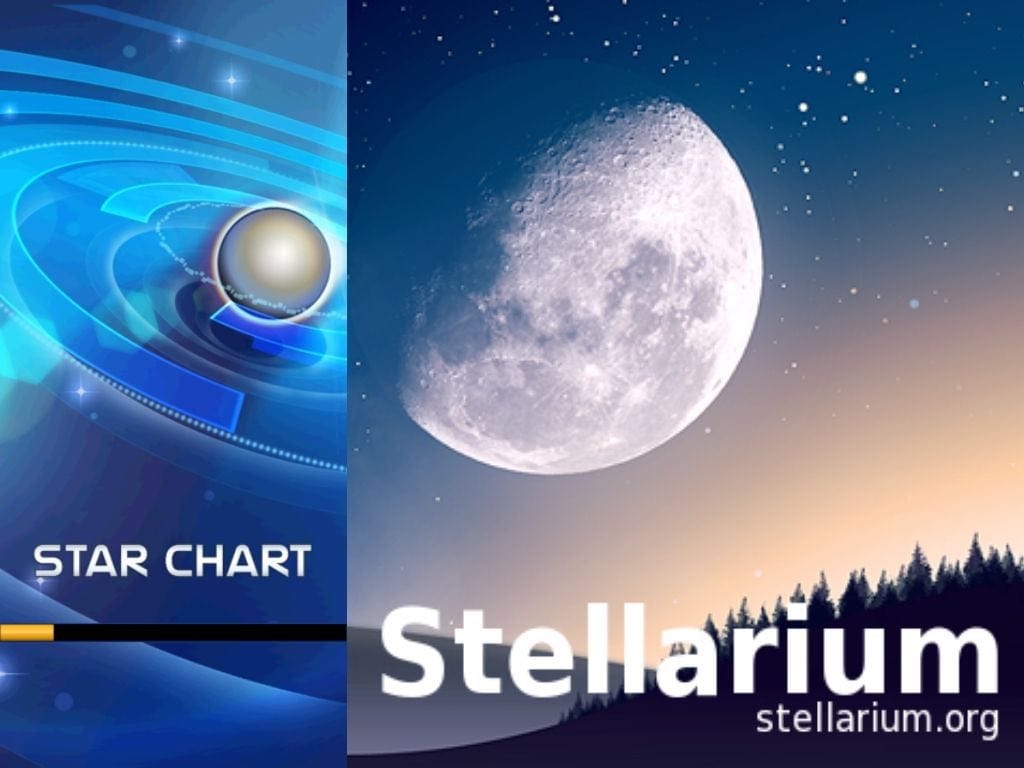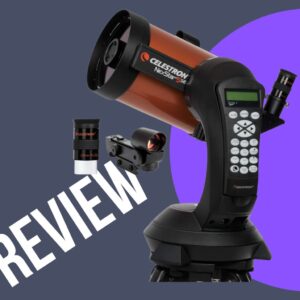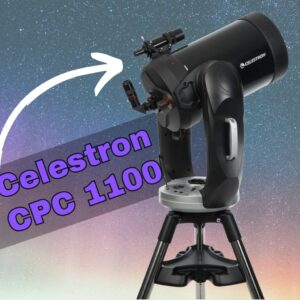This site contains affiliate links to products. I may receive a commission for purchases made through these links.
Discovering the wonders of the night sky has never been easier, thanks to modern technology. Among the various tools available, two apps have consistently stood out for their accuracy, user-friendliness, and rich features: Stellarium and Star Chart. They transform your smartphone or PC into a portable planetarium.
In this guide, we’ll delve into why Stellarium and Star Chart are considered the best stargazing apps on the market, helping you navigate the celestial wonders from the comfort of your home or while on an outdoor adventure.
1. Star Chart – The best free stargazing app for smartphone
Star Chart is a free augmented reality app available for both iOS and Android, devices. This means that when you point your smartphone towards the sky, regardless of whether it’s day or night, the app will display the stars, planets, or other celestial bodies within your field of view.
Although in-app purchases are available, they are not necessary for basic stargazing needs. The free version suffices, offering features like the inclusion of the brightest deep-sky objects such as galaxies and nebulae, known collectively as the Messier catalog. Additionally, it allows users to identify various star constellations, planets, and numerous stars by name.
This app is particularly beneficial for those new to stargazing or with limited astronomy knowledge, providing a user-friendly guide under dark skies. It is also an excellent tool for first-time telescope users, helping them navigate the night sky during their stargazing adventures.
Before utilizing the app, calibration is required. A prompt will appear, guiding you through the calibration process. This involves tilting your device to roll a ball around a circle displayed on your screen, ensuring the ball covers the circle’s exterior. This simple step helps align the app with your current view of the sky, enhancing the overall stargazing experience.

Night mode
After the calibration, you can switch between the night mode and day mode in the settings. Night mode is handy because after activating it, the app will change all the colors on the screen to red.
This is very important when stargazing because the red color has the smallest impact on your night vision. You have to wait till your eyes adapt to the dark to see more stars under the dark skies. Looking at the bright screen of your smartphone will ruin your night vision, so the night mode in red is a must.
How to find objects in Star Chart app
The Star Chart has quite a big catalog of objects. There are all the planets, hundreds of stars, all the constellations, and Messier’s catalog of 110 brightest deep sky objects.

To find an object in the sky, just tap the spying glass icon on the screen, and it will take you to the menu where you can choose from planets, stars, constellations, and Messier objects.
Pick the object you want to find in the sky, and after tapping it, a small arrow will appear on the screen. Move your smartphone in the direction of the arrow, and it will guide you to the chosen object. When you reach the right position in the sky, the object will be highlighted in a small rotating circle. Pretty cool, yeah?
The Star Chart app is user-friendly and ideal for beginners
It provides all the essentials for an enriching stargazing session. In my opinion, it stands out as the premier stargazing application for smartphones.
Additionally, you can personalize your viewing experience by toggling various display settings, such as orbital lines, atmospheric effects, and constellation images, among others.
The app utilizes your GPS to display an accurate representation of the sky based on your current location. Alternatively, you can manually set a different location to explore the sky from other parts of the world.
2. Stellarium – Top free stargazing app
Stellarium is a free open-source software available for Linux, Mac OS X, and Windows, and you can also use Stellarium Web in your internet browser.
It is a planetarium for your computer with a realistic sky in 3D. You can basically stargaze at home and get a massive amount of knowledge about astronomy.
It has so many features that even after many years of using it, I still don’t know all of them. So let me mention just some of them.
Features of Stellarium app
- Catalog of 177 million stars
- catalog of 1 million deep-sky objects
- realistic Milky Way
- images of nebulae and galaxies
- all planets and moons
- time control
- zoom
- telescope control
- moon phases.
I mentioned just a few of the features, and to talk about all of them would require writing a book. You can download the full user manual from the website, which is 365 pages long. But I will tell you about a few features in detail that I’m using most often.
Time control
The time control feature is, for me, the most used one of all when I open Stellarium. You can go back and forward in time so you can plan your stargazing or astrophotography sessions. There are different speeds you can choose. You can go thousands of years back or into the future.
I’m using it mostly for the astrophotography sessions to see which object will be visible on a particular night and for how long. Having this option is very useful for me.
You can also use it to track the moon to see different phases when it is rising, when it is set down, and how high it will be above the horizon.
Search function
When you download Stellarium, it will only have the default catalog of the objects, which is more than enough. Still, if you are a hardcore astronomer like me, you have the option to download extended databases. Then you can find anything you want that is known to date in the universe. You can also download different databases of satellites, asteroids, exoplanets, and more.
When you target an object, it will display every possible information in the top left corner. There is a type of object, magnitude, distance, rise, set, and much more.
To track the object, just hit SPACE BAR, and it will follow the object when you zoom into it. You can zoom in on 3D planets, the moon, and images of the Messier objects.
Display options
It is possible to turn on and off different display options to customize your view in the Stellarium. For example, I like to turn off the atmosphere to see the clear skies and sometimes turn off the ground, so I have a 360-degree view of the universe.
Other options include turning on and off the galaxies, planets, cardinal points, meteor showers, satellites, and exoplanets. You can also switch between equatorial and azimuthal views.
Telescope field of view simulator
This is an amazing feature because it can show you what field of view you get with the telescope and particular eyepiece. This option is in the top right corner, and you have to fill in the data about the telescope and eyepieces you have first.
Then you can combine different eyepieces with Barlow lenses or focal reducers to see the final field of view you will get with a given telescope. It is also very helpful when you are buying a telescope and you want to know how big the magnification will be in real life and if the object will fit in your view.
Field of view for astrophotography
This function is also available on many telescope websites, but here it is more sophisticated. In astrophotography, it is crucial to combine the right telescope with the right camera sensor to get the field of view you need.
Here you can add many different camera sensors where you put specifications like pixel resolution, chip size, pixel size, etc.
It is a powerful tool that I use before every astrophotography session to plan ahead and correctly frame the object I’m going to shoot. This function also helped me with buying the right Astro cameras with the correct sensor size for my telescope.
Telescope control
The last feature that I want to talk about is the option to control the telescope with Stellarium. I have already made an article about this feature called How To Connect Telescope To Computer, so go check it out. But in short, Stellarium has a neat feature to use a lot of plugins and scripts. They are in the settings, and one of the plugins is called Telescope Control.
This is, of course, available only for telescopes with computerized mounts. After connecting the mount with the Stellarium, you can control your telescope from the computer.
Just find the object, press CTRL+1, and the telescope will slew and point to that object. It is not fully controlled; you can’t move your telescope with a press of a button, you always have to pick the object, and then the telescope will slew and point at it.
Summary
The Stellarium provides a huge amount of options to plan your stargazing session or to do astrophotography and learn something about astronomy. I love this piece of software, and I highly recommend it to everyone interested in astronomy and telescopes. It is the best stargazing app on the internet.
Star Chart and Stellarium: Leading stargazing tools for mobile and desktop
The Star Chart and Stellarium are, in my opinion, the best stargazing apps, but there are many other useful apps that you can use. For example, Sky Safari is made by Celestron or Sky View. But no matter what you choose, the most important thing is to have clear skies and passion for the universe.
When I was growing up and learning astronomy, there were no apps or the internet, only books and paper star charts.
These days it is much easier to learn the constellations and objects in the night sky thanks to modern technology and the smartphones that we carry on us every day, now, we can just point them at the sky, and they will show us everything we want to know about the universe…well, not everything 🙂
You may also like:




